What is Gene Interactions?
- Gene interactions encompass the dynamic relationships between genes that collectively influence an organism’s phenotype. These interactions occur when either allelic or non-allelic genes affect the manifestation of specific traits. Unlike the straightforward one-gene-one-trait model initially proposed by Gregor Mendel, gene interactions reveal a more complex genetic landscape.
- Gregor Mendel’s foundational work established the basics of inheritance, focusing on single-gene traits. However, as subsequent research advanced, it became evident that inheritance often involves multiple genes. This complexity was highlighted by the work of early geneticists such as William Bateson and Reginald Punnett. Their experiments with chickens demonstrated that trait inheritance frequently deviates from Mendelian ratios, suggesting the influence of gene interactions.
- In these interactions, genes do not operate in isolation. Instead, the expression of one gene can be modified by the presence or absence of another gene. This phenomenon alters the expected Mendelian ratios, such as the dihybrid ratio of 9:3:3:1 or the trihybrid ratio of 27:9:9:9:3:3:3:1, by affecting how traits develop.
- Consequently, the majority of traits in living organisms are governed by complex interactions among multiple genes. This realization underscores the intricate nature of genetic expression and inheritance, where gene interactions play a crucial role in shaping phenotypic outcomes.
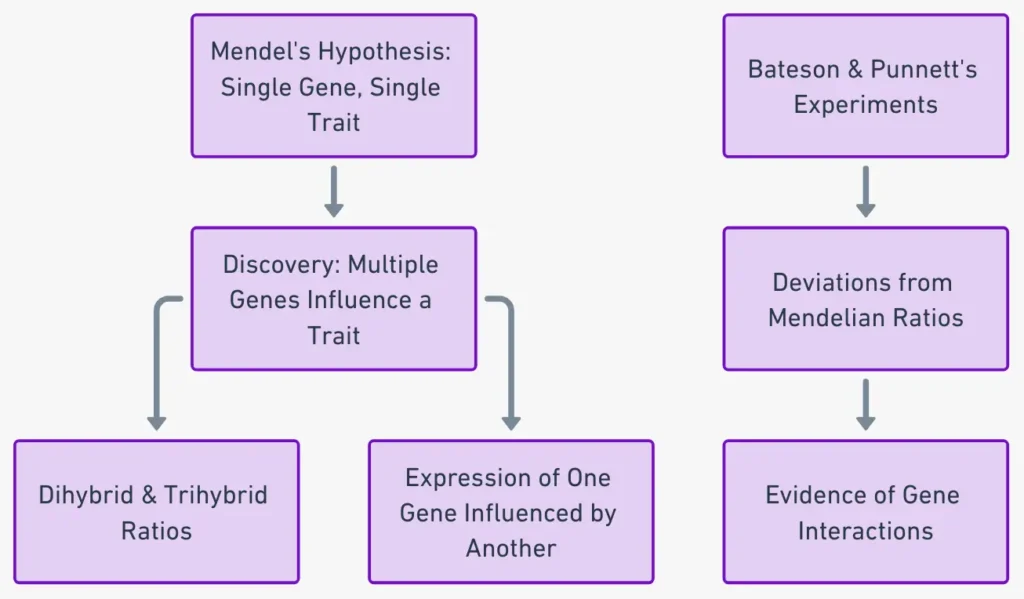
Definition of Gene Interactions
Gene interactions refer to the relationships between multiple genes where the expression of one gene can influence, or be influenced by, the expression of another gene, collectively determining specific phenotypic traits in an organism.
Types of Gene Interaction
Gene interactions can be categorized into two primary types: allelic (or non-epistatic) and non-allelic (or epistatic) interactions. Each type influences phenotypic expression in distinct ways.
1. Allelic (Non-Epistatic) Gene Interaction
- Definition: This interaction occurs between alleles of the same gene.
- Ratios: Typically results in classical Mendelian ratios such as 3:1 for single-gene traits. For example, in a monohybrid cross, the phenotypic ratio of dominant to recessive traits is 3:1.
- Function: Involves the interaction of different alleles at the same gene locus, affecting trait expression based on the dominance or recessiveness of these alleles.
2. Non-Allelic (Epistatic) Gene Interaction
- Definition: This interaction involves genes located on either the same chromosome or different chromosomes that influence each other’s expression.
- Ratios: Deviates from the classical Mendelian ratios, such as modifying the expected 9:3:3:1 ratio in dihybrid crosses.
- Function: Epistasis occurs when the expression of one gene masks or modifies the expression of another gene. This can involve:
- Complementary Gene Interaction: Both genes are required for the expression of a trait.
- Duplicate Gene Interaction: Two genes that provide the same function; either gene can produce the trait if present.
- Suppressive Gene Interaction: One gene suppresses the effect of another gene.
- Modifier Gene Interaction: One gene modifies the expression of another gene, altering the phenotype.
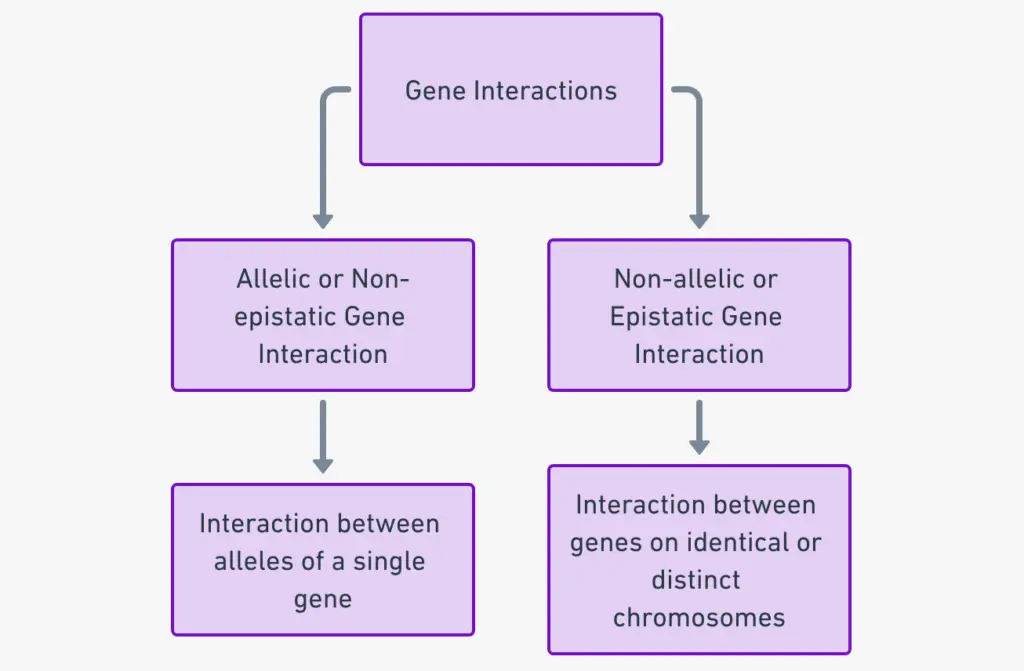
Other Types of Gene Interactions
Below is a detailed examination of these various gene interactions:
- Modifiers
- Definition: Modifiers are genes that alter the phenotypic effect of a major gene without themselves being responsible for a specific trait. These genes can either enhance or reduce the expression of the primary gene in a quantitative manner.
- Example: In various species, genes responsible for diluting body color act as modifiers. For instance, a gene that dilutes pigmentation can change the intensity of color produced by another gene responsible for color development.
- Suppressors
- Definition: Suppressor genes are those that inhibit the expression of a mutant allele of another gene, leading to the restoration of the wild-type phenotype. This suppression occurs through various mechanisms that prevent the mutant allele from manifesting.
- Example: In Drosophila, the suppressor gene Su-s can suppress the expression of the dominant mutant gene responsible for the star-eye phenotype, thereby resulting in a wild-type eye appearance.
- Pleiotropy
- Definition: Pleiotropic genes are those that have multiple effects on different traits. A single gene influences several phenotypic characteristics, often through a common biochemical pathway or developmental process.
- Example: In Drosophila, certain pleiotropic genes affect various traits such as bristle number, eye shape, and wing structure, and significantly influence the number of facets in bar-eyed individuals. This means a single gene can have wide-ranging effects on the organism’s phenotype.
- Atavism
- Definition: Atavism refers to the reappearance of ancestral traits in an organism that were not present in recent generations. This phenomenon often occurs when a trait thought to be lost reemerges due to the activation of ancient genetic pathways.
- Example: Atavistic traits can include physical features or behaviors that resemble those of distant ancestors, reflecting the reactivation of genes that had been previously suppressed.
- Penetrance
- Definition: Penetrance is the extent to which a gene is expressed phenotypically in individuals carrying it. It can be complete, where all individuals with a particular genotype express the associated phenotype, or incomplete, where the phenotype is not consistently observed in all individuals with the genotype.
- Example: In peas, the R allele for red flowers exhibits complete penetrance as it is expressed in all homozygous and heterozygous individuals. In contrast, the P allele for polydactyly in humans may exhibit incomplete penetrance, where some individuals with the dominant allele do not show the polydactylous condition.
- Expressivity
- Definition: Expressivity refers to the degree of variability in the expression of a trait among individuals with the same genotype. A trait may be uniformly expressed or vary significantly in its manifestation.
- Example: In human polydactyly, expressivity can vary, with the condition being evident on one hand but not the other. This variability in phenotypic expression, despite the presence of the same genotype, illustrates the concept of expressivity.
Allelic or Non-epistatic Gene Interaction
Allelic gene interactions involve the ways different alleles of a single gene influence an organism’s phenotype. These interactions can be categorized into several types, each with distinct effects on gene expression and inheritance. Below is a detailed examination of key types of allelic gene interactions:
1. Complete Dominance
- Definition: Complete dominance occurs when one allele of a gene completely masks the effect of the other allele. This interaction adheres to Mendelian inheritance principles.
- Mechanism: In this pattern, the dominant allele’s presence results in the expression of the dominant phenotype, while the recessive allele’s effect is not visible.
- Historical Example: Archibald Garrod’s study on alkaptonuria in 1903 illustrated complete dominance. Garrod noted that the disease, characterized by homogentisic acid in urine, followed a 3:1 ratio in family studies, consistent with Mendelian inheritance.

2. Incomplete Dominance
- Definition: Incomplete dominance occurs when two different alleles of a gene combine to produce a phenotype that is a blend of the parental traits.
- Mechanism: Neither allele is completely dominant; instead, the heterozygous phenotype is an intermediate between the two homozygous phenotypes.
- Example: In snapdragons, crossing red-flowered plants with white-flowered plants results in offspring with pink flowers. When these hybrids are bred, the F2 generation shows a phenotypic ratio of 1 red:2 pink:1 white, demonstrating the blending of traits.
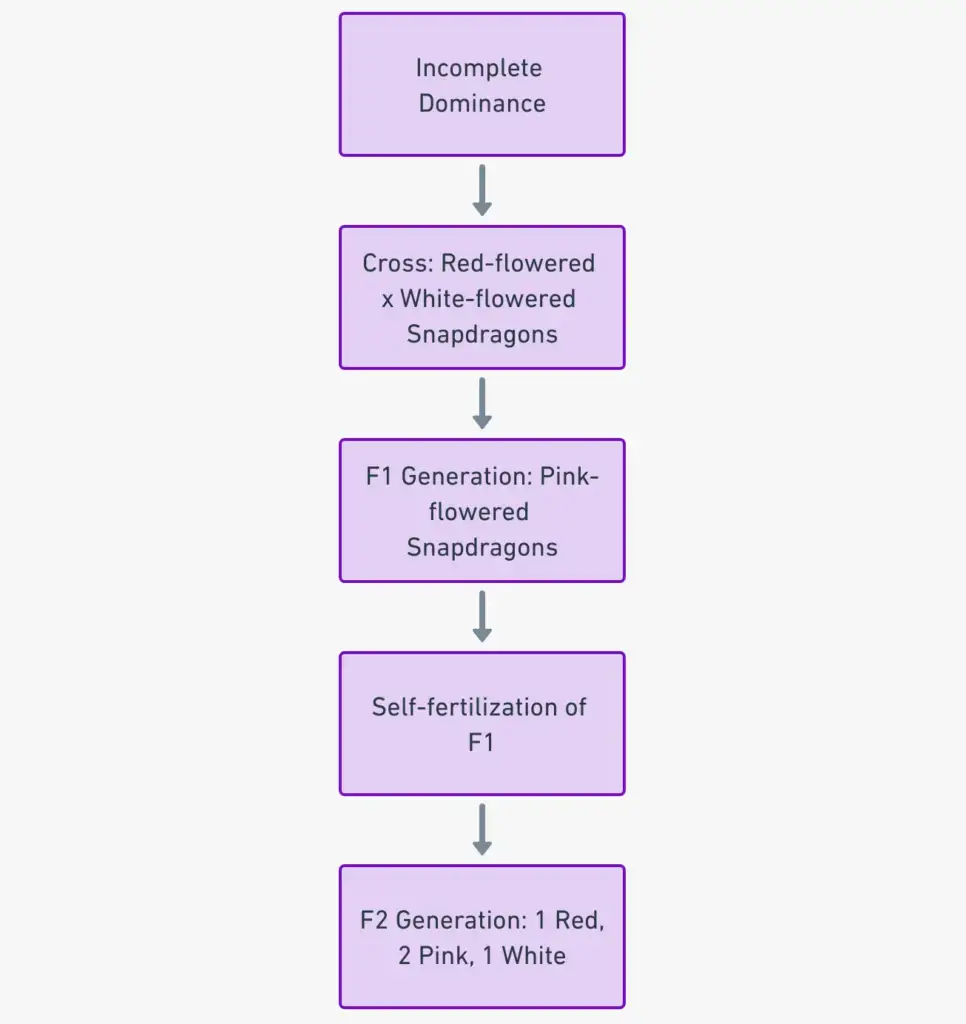
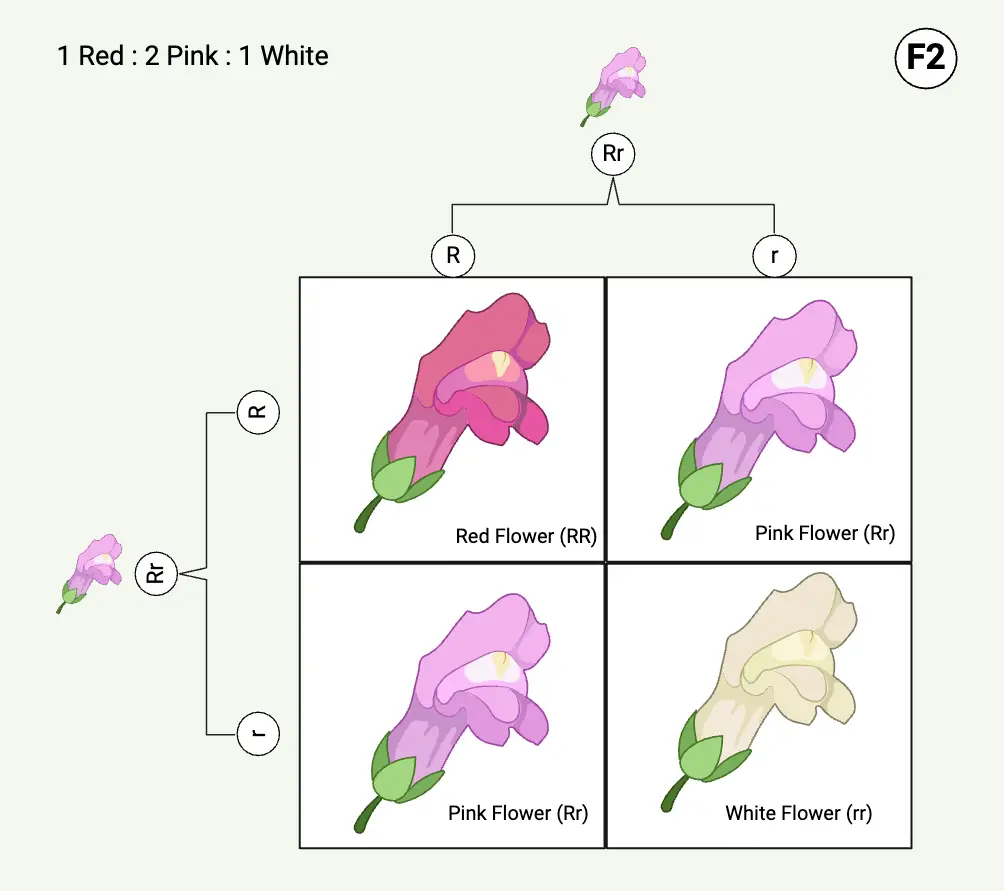
3. Codominance
- Definition: Codominance involves the simultaneous expression of both alleles of a gene, where neither allele is dominant over the other.
- Mechanism: Both alleles contribute equally and independently to the organism’s phenotype, leading to the presence of both traits simultaneously.
- Example: The ABO blood group system in humans is a classic example of codominance. In this system, the A and B antigens are both expressed on the red blood cells, resulting in phenotypes such as AB blood type where both antigens are visible.
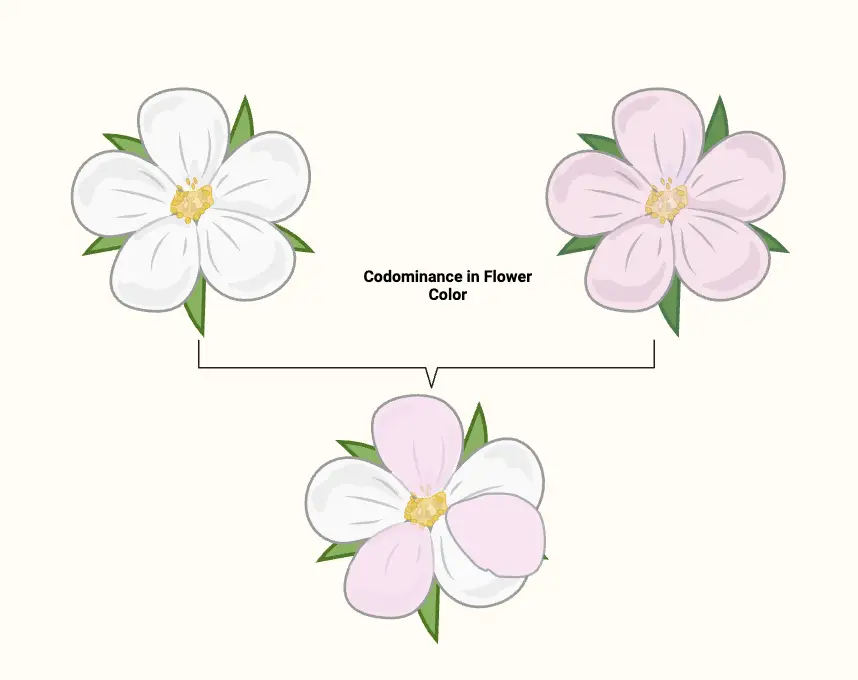
4. Lethal Alleles
- Definition: Lethal alleles are mutations that disrupt essential biological functions and can result in the death of the organism.
- Types:
- Dominant Lethal Alleles: These alleles cause death early in development, often preventing the individual from reaching reproductive age. If lethal alleles act later in life, they can still be passed on to the next generation.
- Recessive Lethal Alleles: These alleles may not affect the organism if only one copy is present (heterozygous condition). They can persist in populations as heterozygotes and only cause lethality when two copies are present.
- Example: In mice, the yellow-lethal allele (AY) results in yellow fur but is also recessive lethal. Mice with two copies of AY die early, while heterozygotes (AYA+) and wild-type (A+A+) mice are observed in a 2:1 ratio in progeny.
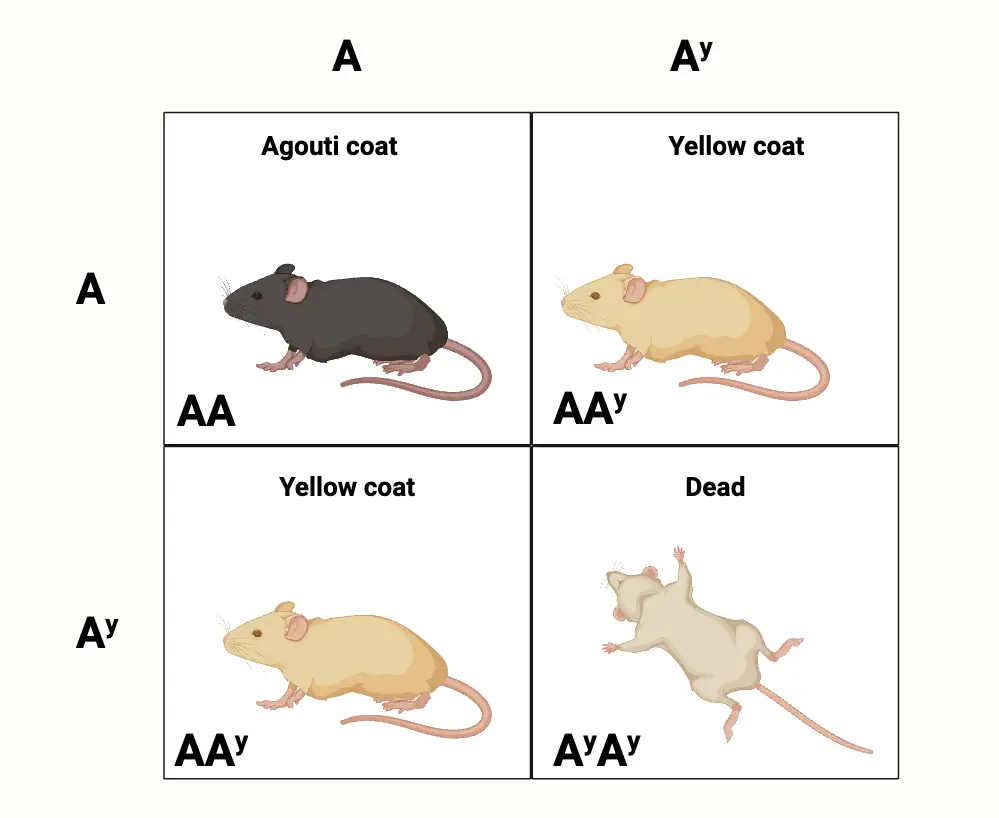
5. Multiple Alleles
- Definition: Some genes have more than two allelic forms, expanding beyond Mendel’s original concept of a gene having only two alleles.
- Mechanism: Multiple alleles exist at the same gene locus, creating various combinations that influence the phenotype in a more complex manner.
- Example: In rabbits, the gene for coat color exhibits multiple alleles: c (Albino), ch (Himalayan), cch (Chinchilla), and c+ (Wild-type). The diversity in coat color among rabbits is due to these multiple alleles, each contributing differently to the phenotypic expression.
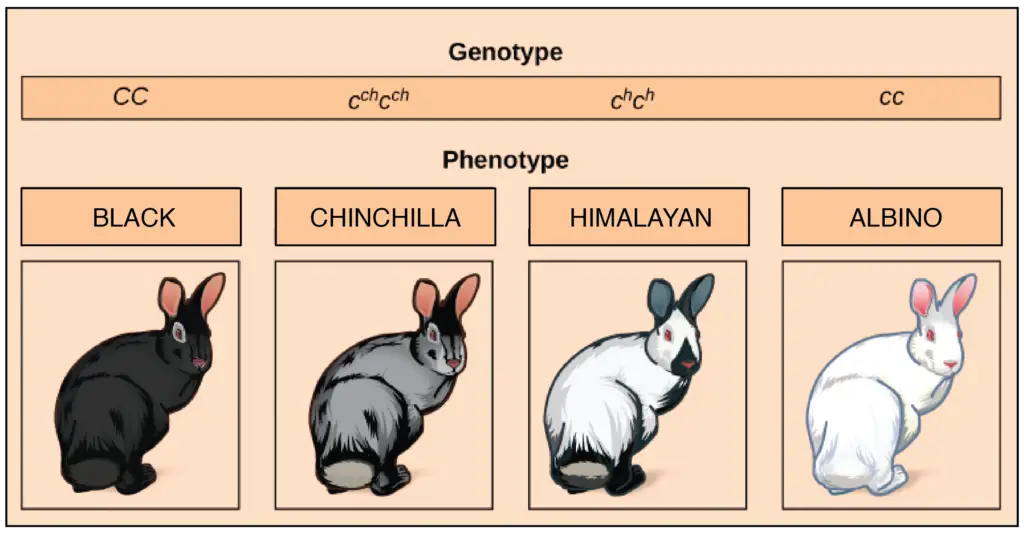
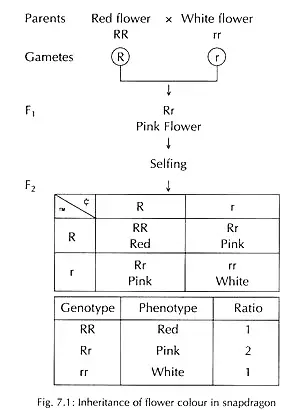
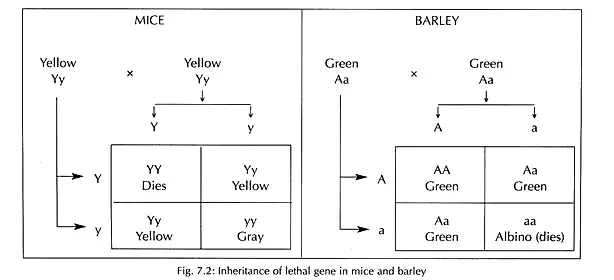
Non-Allelic Gene Interaction
Non-allelic gene interactions involve the interplay between different genes that are not alleles of the same gene. These interactions occur between genes located on the same or different chromosomes and influence the expression of traits in various ways. Key types of non-allelic gene interactions include:
1. Complementary Genes
- Definition: Complementary gene interactions occur when two or more genes at different loci collaborate to produce a specific phenotype. Each gene provides a distinct function necessary for the trait’s expression.
- Mechanism: For a phenotype to manifest, the combined action of these genes is required. If any one of these genes is non-functional or absent, the phenotype will not be expressed.
- Example: In sweet peas, the genes C and P are involved in the biosynthesis of anthocyanin pigment, which imparts a purple color to the flowers. Both genes must be present and functional for the pigment to be produced. If either gene is missing, the flowers will be white, illustrating the complementary nature of genes C and P in anthocyanin synthesis.
2. Epistasis
- Definition: Epistasis describes a genetic interaction where the effect of one gene (the epistatic gene) masks or modifies the effect of another gene (the hypostatic gene). This interaction can alter the expected Mendelian ratios.
- Mechanism: The epistatic gene affects the expression of the hypostatic gene, potentially altering or completely masking its phenotypic outcome.
- Historical Context: The term was introduced by William Bateson in 1907 to account for deviations from Mendelian inheritance patterns.
Types of Epistasis:
- Dominant Epistasis: Occurs when a dominant allele at one locus masks the expression of alleles at another locus.
- Example: In foxgloves (Digitalis purpurea), the interaction between the genes d/D and w/W determines petal color. The W allele controls where pigment is synthesized, and its dominant form restricts pigment production to throat spots, resulting in white petals with colored spots. This dominant W allele shows epistasis by preventing red pigment synthesis in the petal areas outside the throat spots.
- Recessive Epistasis: Occurs when the recessive allele at one locus hides or suppresses the effects of alleles at another locus.
- Example: In Labrador retrievers, the yellow coat color is due to recessive epistasis. The e allele acts epistatically to mask the effects of the B (black) and b (brown) coat color alleles. The presence of the recessive e allele results in a yellow coat, regardless of the other coat color alleles.
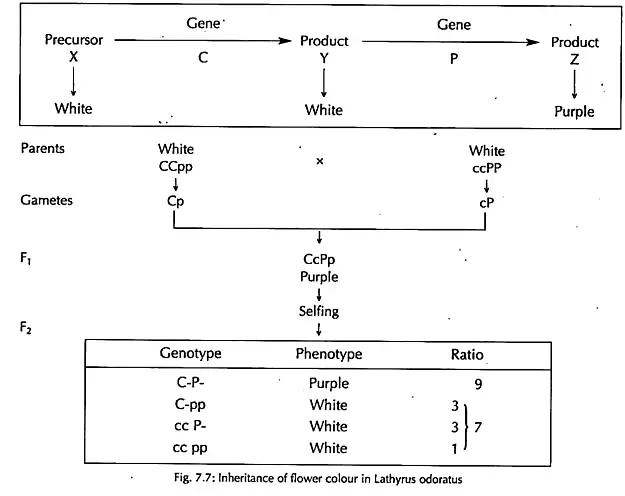
Classification of Epistasis Gene Interaction
Epistatic interactions can be classified into several categories based on their functional relationships. Here, we detail the major types of epistatic interactions:
1. Supplementary Gene Interaction
- Definition: In supplementary gene interactions, the phenotypic effect of a gene is modified by the presence of a dominant allele from another gene. The dominant allele of one gene can influence the expression of another gene, but does not show an independent phenotypic effect.
- Example: In mice, the agouti (grey) coat color is regulated by a supplementary gene interaction. The presence of dominant alleles from two genes (e.g., C and A) determines the coat color, with specific combinations leading to different phenotypes.
- Phenotypic Ratio: In a typical F2 generation, the observed ratio is 9 (Agouti):3 (Colored):4 (Albino).
2. Complementary Gene Interaction
- Definition: Complementary gene interactions occur when two different genes work together to produce a specific phenotype. Both genes must be present in their dominant form to express the phenotype. If either gene is homozygous recessive, the phenotype is not expressed.
- Example: In sweet peas, the combination of dominant alleles (CC and PP) produces a colored flower, while the presence of recessive alleles (cc and pp) results in a white flower. The F2 ratio in such cases is 9:7.
3. Inhibitory Gene Interaction
- Definition: Inhibitory gene interactions occur when a recessive allele at one gene locus inhibits the phenotypic expression of another gene. Here, the dominant allele’s effect is suppressed by the recessive allele.
- Example: In certain genetic crosses, the ratio shifts from 9:3:3:1 to 13:3 due to the presence of a dominant inhibitory allele. The homozygous recessive condition inhibits the expression of other alleles.
4. Duplicate Gene Interaction
- Definition: Duplicate gene interactions occur when two different genes have similar effects on a phenotype. When either gene is dominant, the phenotype is expressed, leading to a combined effect. This interaction typically results in a 15:1 phenotypic ratio.
- Example: In the shepherd’s purse plant, the seed capsule shape is influenced by duplicate gene interaction, where the presence of dominant alleles at either of two loci results in a triangular capsule, while recessive alleles produce an ovoid shape.
5. Masking Gene Interaction
- Definition: In masking gene interactions, a dominant allele of one gene masks the expression of another gene. The masking gene’s dominant allele overrides the effects of the other gene’s alleles.
- Example: When a dominant allele (A) masks the phenotypic expression of another gene (B), the gene A is said to be epistatic to gene B. The recessive allele of gene B will only express its phenotype in the absence of the dominant allele of gene A.
6. Polymeric Gene Interaction
- Definition: Polymeric gene interactions involve two or more genes where each dominant allele contributes additively to a phenotype, leading to a range of phenotypic variations. The combined effect of these alleles results in multiple phenotypes.
- Example: In various organisms, polymeric interactions produce a range of traits due to the additive effects of multiple dominant alleles. For instance, the degree of pigmentation in certain plants can vary depending on the number of dominant alleles present.
Importance of Gene Interactions
- Understanding Functional Relationships:
- Gene interactions reveal how genes collaborate to influence biological functions. By studying model organisms, researchers can map out these relationships, which is crucial for understanding how genetic information is translated into traits.
- Clarifying Genetic Pathways:
- Genes do not operate in isolation; rather, they function within complex pathways. Gene interactions help elucidate these pathways by showing how genes and their products work together to produce specific phenotypic outcomes. For example, in metabolic pathways, multiple genes coordinate to catalyze biochemical reactions.
- Explaining Phenotypic Variation:
- The variation observed in phenotypes among individuals of the same species often results from interactions between multiple genes. This complexity can lead to diverse traits even among genetically similar organisms. Understanding gene interactions allows scientists to decipher how various genetic combinations contribute to phenotypic diversity.
- Tracing Evolutionary Changes:
- Gene interactions are pivotal in studying the evolution of genetic systems. Observing how genes interact and evolve over time helps researchers understand the dynamics of genetic changes and the development of new traits. This knowledge is essential for tracing the evolutionary history of organisms and their adaptive mechanisms.
- Unraveling Molecular Mechanisms:
- The mechanisms underlying gene interactions are intricate, involving various molecular processes such as gene regulation, epistasis, and genetic recombination. Studying these mechanisms is crucial for comprehending how genes modulate each other’s activity and how these interactions affect biological functions.
- Applications in Genetic Research:
- Research on gene interactions has practical implications, including the development of genetic therapies and the improvement of crop varieties. By understanding how genes interact, scientists can design interventions that correct genetic defects or enhance desirable traits.
FAQ
What is a gene interaction?
Gene interaction refers to the phenomenon where multiple genes influence a single phenotype or trait. It’s the interplay between genes that determines how they express themselves in an organism.
How do gene interactions differ from Mendelian inheritance?
While Mendelian inheritance focuses on the inheritance patterns of single genes, gene interactions consider the combined effects of two or more genes on a single phenotype.
What is epistasis?
Epistasis is a type of gene interaction where one gene masks or modifies the effect of another gene. It can alter expected Mendelian phenotypic ratios in the offspring.
How is complementary gene interaction different from supplementary gene interaction?
In complementary gene interaction, two non-allelic genes work together to produce a phenotype. Both genes are required for the trait to manifest. In supplementary gene interaction, one gene modifies the phenotype produced by another gene.
What is meant by the term “masking” in gene interactions?
“Masking” refers to the phenomenon where the effect of one gene (the epistatic gene) hides or overshadows the effect of another gene (the hypostatic gene).
Why are gene interactions important in understanding phenotypic outcomes?
Gene interactions provide a more comprehensive understanding of how traits are expressed. They explain why some phenotypic ratios deviate from expected Mendelian ratios and offer insights into the complexity of genetic control in traits.
Can gene interactions be influenced by environmental factors?
Yes, the expression of genes and their interactions can be influenced by environmental conditions. This interplay between genes and the environment can lead to varied phenotypic outcomes.
What is a polygenic trait?
A polygenic trait is controlled by multiple genes, each contributing a small effect to the overall phenotype. Height, skin color, and intelligence are examples of polygenic traits.
How do duplicate gene interactions work?
In duplicate gene interaction, two genes control a trait, and the presence of a dominant allele in either of the genes can produce the same phenotype. The combined effect of both genes doesn’t enhance the trait further.
Are gene interactions the same in all organisms?
While the basic principles of gene interactions are consistent across organisms, the specific interactions and outcomes can vary based on the organism’s genetic makeup and evolutionary history.
- https://www.ramauniversity.ac.in/online-study-material/fet/biotechnology/btech/iv-semester/genetics/lecture-8.pdf
- Moore, J. H. (2013). Gene Interaction. Brenner’s Encyclopedia of Genetics, 200–201. doi:10.1016/b978-0-12-374984-0.00592-1
- Goodnight, C. J. (2016). Gene Interactions in Evolution. Encyclopedia of Evolutionary Biology, 104–109. doi:10.1016/b978-0-12-800049-6.00048-2
- https://www.slideshare.net/harshrajshinde1/gene-interaction
- https://www.turito.com/learn/biology/gene-interactions-grade-10
- https://www.ndsu.edu/pubweb/~mcclean/plsc431/mendel/mendel6.htm
- https://www.csun.edu/~cmalone/pdf360/Ch04-2extensions.pdf
- https://www.brainkart.com/article/Intergenic-gene-interactions_38215/
- https://edurev.in/question/2248075/Types-of-gene-interactions-
- https://www.researchgate.net/figure/Types-of-gene-gene-interactions-1_fig1_258524366
- https://www.turito.com/learn/biology/gene-interactions-grade-10
- https://www.mmcmodinagar.ac.in/econtent/botany/Gene-interaction.pdf
- https://www.biologydiscussion.com/genetics/gene-interactions/gene-interactions-allelic-and-non-allelic-cell-biology/38795
- https://byjus.com/neet/gene-interaction/
- Text Highlighting: Select any text in the post content to highlight it
- Text Annotation: Select text and add comments with annotations
- Comment Management: Edit or delete your own comments
- Highlight Management: Remove your own highlights
How to use: Simply select any text in the post content above, and you'll see annotation options. Login here or create an account to get started.